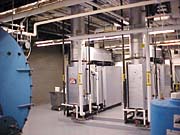Some newer boilers are also able to deal with a particularly troublesome operation problem, wild load swings.
As the name implies, wild load swings are caused by sudden changes in the load. “In many industries and institutions, high steam volume is needed suddenly at different times of the day,” explained Mark Utzinger, vice president of Miura Boiler’s U.S. operation, Miura Boiler West, Inc. “When that large volume is needed, it has to be there immediately. In between demands the boiler doesn’t even have to be on, or it may be running at an idle speed.”
According to Utzinger, this cyclical, heavy-demand steam usage can lead to heavy system wear and unreliable operation.

SWING RESULTS
Low water:When the boiler’s load swings back to large volume from low volume, “often one boiler just cannot produce enough steam,” Utzinger said.“When a [system] requires a huge volume of steam, the moment a valve is opened to provide it, too much steam may be drawn from the boiler. In fact, it can pull all the steam into the line, causing a siphoning action that can pull not only steam out of the boiler, it can suck out the reservoir of water that’s forming the steam.”
Such a low-water situation automatically shuts down the boiler.
Slow response: In critical-use facilities such as hospitals, low-water shutdowns are intolerable. These facilities generally install two or more boilers as backups. However, “This does not always solve the problem satisfactorily,” Utzinger said.
“The backup boiler, because it’s idling and not up to full steam, cannot produce the needed steam fast enough. So, the necessary volume of steam is not available when it is needed, and it could take as long as 30 minutes to build up.”
Cracked tubes: When a steam valve is opened, steam is abruptly drawn from the boiler. The boiler’s burner ramps up from its low-fire, idling state to full fire as it tries to meet the demand of the draw on the steam.
The firetubes quickly expand as the heat within them increases — and they contract just as quickly when the steam demand drops off, Utzinger explains. “In fact, cold air may rush over the tubes when the boiler cycles from full fire to low fire.”
This contraction and expansion creates problems. “The metal of the tubes is being forced in and out of the tube sheet over and over again,” says Utzinger. “In time, it will crack the tubes of a firetube or coiled-tube boiler.”

ONE HOSPITAL’S DEMANDS
Kaiser Hospital in Sunnyside, OR, had two 300-BHP boilers and one 500-BHP Scotch Marine firetube boiler. The initial problem was, when the facility had a heavy draw for heat and sterilizers, one boiler could not produce enough steam fast enough to keep up, so the other boiler would have to kick in.The secondary problem: The backup boiler couldn’t kick in fast enough.
Wayne Daggett, maintenance manager at Kaiser, describes it like this: “In the wintertime, the two 300-horsepower boilers would not hold the load. So, we’d have to run the 500-BHP firetube boiler with a 300 BHP in standby, staying warm. In the summertime, we had one 300 BHP online with the other 300-BHP firetube in standby.”
GVA Northwest, LLC, an HVACR manufacturers’ rep firm in Portland, analyzed the situation for Kaiser. A report concluded that it wasn’t the size of the firetube boilers that was the problem, it was the suddenness of the upsurges in the hospital’s steam demands and the boilers’ inability to respond in time.
The firetube boilers took as long as half an hour to kick into high gear, reported GVA’s John Hilton; the hospital needed a boiler that could be up to steam in minutes. GVA recommended that the hospital install two 200-BHP Miura LX watertube boilers.
PURCHASING PERSUASION
Making purchasing decisions in hospitals typically isn’t easy. Kaiser and other hospitals have purchasing programs that include a list of accepted products and vendors. Miura began North American operations in 1988, making it relatively new in the American boiler market. The company was not on Kaiser’s list.(The company does have a significant international boiler presence, with seven manufacturing plants around the globe and roots in Japan.)
GVA decided that showing the boilers in operation would speak volumes. Hilton and a coworker took Daggett and Dave Kath, the hospital’s chief engineer, to the Miura installation at Portland Brewery (a lunchtime visit, Hilton pointed out). Hilton reported that Daggett timed the brewery’s boiler and said, “My gosh, it does go from a cold boiler to a full head of steam in five minutes!”
Daggett and Kath recommended the boilers. According to Hilton, they have “the proper ears to talk to within the Kaiser organization, as well as the respect.”
Daggett, with 22 years at the VA Hospital in addition to his experience at Kaiser, said, “When we installed the 200-BHP Miuras, we put the 500-BHP Scotch Marine in a lay-up condition. Now we’re not even using it.”
According to Hilton, “The 500-BHP Scotch Marine will be removed later with future expansion and dual-fuel Miuras will be put in.” He reckons this will allow the system to supply steam to the expansion from one boiler plant. “With the big firetubes or watertubes, this would not be an option,” he said. “They would have to plan another boiler plant to supply any expansion.”
ADDED EFFICIENCY
“The boilers modulate themselves as the load dictates,” Daggett explained. The resulting efficiency increase is one more benefit, and a big one. “The firetube boilers couldn’t keep up with the load because of their inefficiency,” he said.Hilton pointed out, “If you figure that previously, 600 to 800 horsepower was required for peak demand and now it’s just 400, it is not surprising that the hospital estimates they are saving 25% on their fuel bill.”
Apparently, very little heat radiates from the new boilers. Chief engineer Kath said, “I have to wear my coat in the boiler room now.” It’s a small price to pay.
Publication date: 09/23/2002

Report Abusive Comment